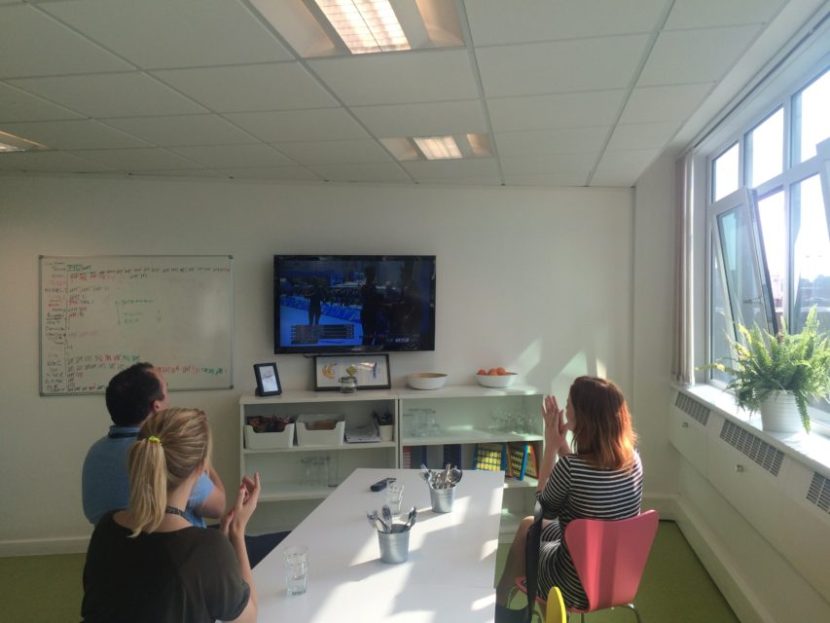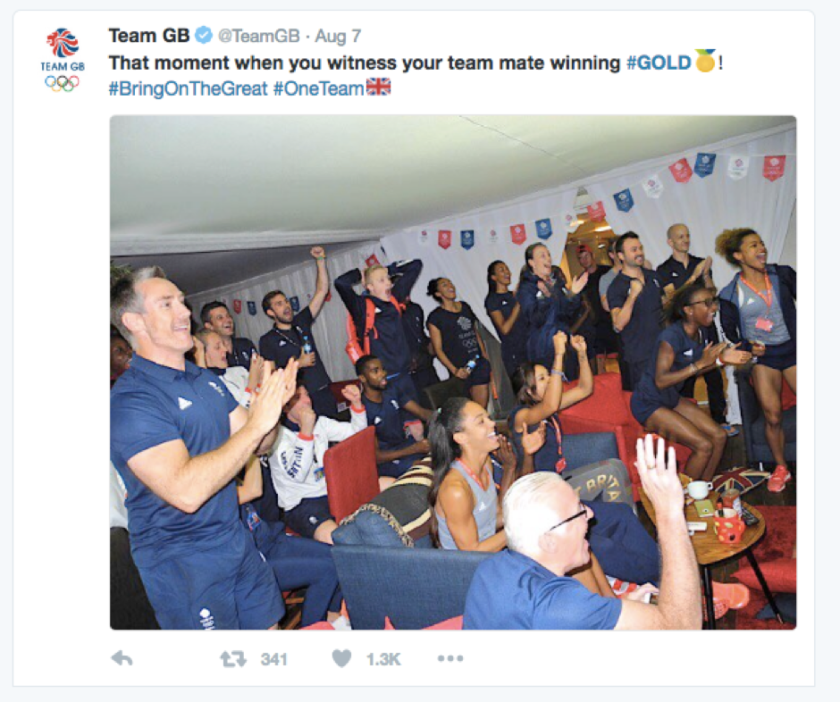Internal organizational culture and the 2016 Rio Olympics
What can the Olympics teach us about the challenge and value of building a company brand and identity?
The past 2 weeks have seen the world’s nations take to the global stage in the biggest sporting event in the calendar: The Olympic Games. Rio 2016 has seen outstanding performances and success from individuals across multiple disciplines, captivating audiences with every event from diving to rugby, tennis to dressage or track to rowing and more. At Interact, we’re proud to be supporting both the leading nations at the top of the medal table, with our US and UK offices getting behind both countries in a show of support.

Enjoying the conclusion of the Triathlon in the UK office!
While the focus is largely on celebrating individual feats and those standing upon the podium, alongside demonstrations of great sportsmanship, courage or sheer determination, there are great lessons to be learned from the world’s biggest teams. Most fundamentally, The Olympic Games personify a great philosophy that many companies will recognize in an age of growing globalization: the coming together of individual “silos” and teams under one, unified, national identity.
The challenge: One nation, one team?
The ability to unite multiple, individual sports under one brand is no simple task. Given the degree of focus required to excel at international level in any given sport, it’s likely that not only will individual athletes have not met the majority of their national teammates, but they may have limited understanding of their different sports or events. They will have crossed paths with their competitors more frequently than their national allies. Similarly, during training and build-up, it’s likely they will spend the majority of time with their immediate sport teammates.
For those sports only recently entering the Olympic domain (rugby and golf in 2016), this is also new territory – athletes have operated on a global scale previously, but never as part of their national Olympic team. All events see different levels of popularity within the media and public domain, resulting in differing levels of engagement with their umbrella national identity.
Some of the newer athletes on the circuit also admit being ‘nervous’ about meeting iconic top-level competitors or uneasy about approaching counterparts from different sports. Even within the same sport, there can be uneven amounts of media attention that can cause rifts or a sense of not feeling ‘included’ in the bigger picture (just ask synchronized swimming bronze medal winner Dan Goodfellow, whose role next to media star Tom Daley was largely overlooked by the media – resulting in an outraged backlash from his own mother on Twitter).
It’s a challenge not too far removed from any organization operating across different office locations or even just different departments. The majority of individuals work on a day-to-day basis within their own silos and without engagement with remote workers or other departments. New starters can often struggle to feel engaged with a company culture and may face resistance from established silos; those working at a junior or entry level can find the idea of communicating with top-level decision-makers daunting or simply unrealistic. Building a centralized company brand identity where individuals genuinely feel part of the whole is an increasing modern-day challenge.
However, business success – like that of our Olympic teams – is dependent not only upon individual input and effort, but driven by the collaboration and support of others. What’s more, people perform at their best when unified and engaged with the overall business culture and brand, alongside its goals and objectives.
Is it possible to make every individual, from CEO (or Michael Phelps?) level down to your part-time finance assistant, feel ‘part of the bigger picture’
Why does it matter?
“You show up at the Olympics, and you’re no longer you; you’re an American Olympian. You’re part of this greater whole, and the individual doesn’t matter.’ – Shaun White, Team USA 2010; 2014.
In 2012, Men’s tennis singles gold medal holder Andy Murray recalls the experience of watching team mates Mo Farah, Greg Rutherford and Jessica Ennis-Hill on the infamous “Super Saturday” for Team GB… before going on to secure his first Olympic medal against rival Roger Federer the following day. Inspired by their example and the backing of his home crowd at the London 2012 Olympics, Andy Murray openly considers himself “part of a team” – an additional motivation on the world stage.
Identifying with, and being motivated by the concept of a larger team or goal is nothing new. Research shows those who are engaged with their team or business vision perform better, are more productive, and deliver greater results than those acting independently as a silo. The power of a team ethos and spirit makes for greater satisfaction and happiness at individual level and also generates increased loyalty, with those individuals likely to go above and beyond the expected as a result.
Acting as ‘one team’ also enhances the experience for the customer – or, in the instance of the Olympics, the supporters. Having an internal organizational culture which brings together all individual groups creates a core brand identity and promotes brand communities: who will identify with and support all elements of that brand. In the case of Team GB and Team USA, this sees a marked increase in viewers for even those sports traditionally considered ‘less popular’ – and a subsequent boost to the support and recognition individuals within those silos or sports receive as part of their national brand.
In the business marketplace, when employees act according to their brand and are engaged with their employer, the result is measurable improvements in customer service and experience, and a boost to customer loyalty to that brand.
Building “One Team”
“The greatest memory for me of the Olympics was not the individual honors, but standing on the podium with my teammates to receive our team gold medal.”
– Mitch Gaylord, Team USA 1984.
The Olympics’ current two top nations, Team GB and Team USA, have strived to overcome incidences of ‘silos’ and bring together their athletes and supporters for this summer’s Games. Both team names have now become synonymous with a bigger image and identity, carefully constructed and communicated to attach each individual – regardless of sport discipline or level – to a unified, greater ‘whole’.
Whether this comes in the form of the carefully selected and nation-branded Team kit, the practice of housing national competitors together in the Olympic village or the patriotic displays of all Olympians walking together at the opening ceremony, the message is re-emphasized at every point. Head of Marketing for Team GB, Leah Davis, also pointed to the use of social media to rally support, inspire athletes and bring together all the different silos within the Games:
“Our strategy around Rio 2016 is very much about engaging the public, getting them to show their support for Team GB and using that support to inspire the athletes.”
“What we’re trying to do from a social media aspect is connect the athletes to the fans so the fans feel that by submitting their messages online or via social media they can actually reach that athlete. It’s very much about using social media to bridge the gap between the two.”
One notable example of the success of this team ethos and brand in action was the Team GB reaction to their first gold medal of Rio 2016, tweeted on the official account:

Despite a technical glitch temporarily delaying the key moment as the TV ‘rebuffered’, the message was clear: from the heart of their place in the Olympic village, Adam Peaty’s team were behind him. The associated #hashtag on the image captured the philosophy: #OneTeam.
Creative communications agency Krow, who also worked on the Team GB “Bring on the Great” campaign, performed preliminary research that showed 68% of Brits intended to watch Team GB in Rio, with 67% of respondents reporting that the brand is a team the country can get behind as a whole.
Bringing together your silos
“Seeing your country’s flag go up as you get a gold medal is the best thing you can achieve.” – Abby Wambach, Team USA 2004, 2008, 2012.
Observing the practice of the Team GB and Team USA examples, it’s clear that the creation of a unified company brand and identity is achievable with the right tools and approach.
Most significantly, we’ve seen:
- Use of all social media channels to engage supporters with the different sporting events and individuals, increasing the sense of ‘oneness’ amongst athletes – including @mentioning the individual teams and utilizing the team #hashtags to bring together all the relevant content in a central digital ‘hub’
- Celebration of success: every medal, regardless of sport, level or individual is recognized and communicated through all the official Team channels
- A strong defined branding strategy, which filters into all communications and collateral for both Team GB and Team USA
- Aligning the internal and the external: using the rallying of supporters and their input to build support, contributing to the creation and visibility of the brand
- A focus on ‘stories’ – telling the back story behind athletes, with content ranking of upmost importance; team members each have a biography and space on the team sites
Whatever our Teams bring home, it’s clear that the approach to building the brand of both #TeamUSA and #TeamGB has contributed towards the outpouring of national pride, patriotism and support – fuelling the outstanding performances from both teams in what is set to complete as one of the best Olympic Games in history.
Go #TeamUSA and #TeamGB!
